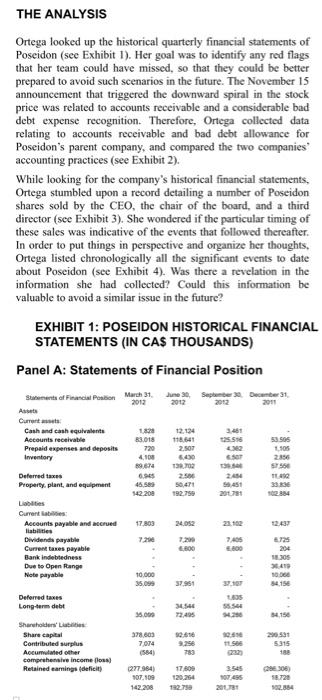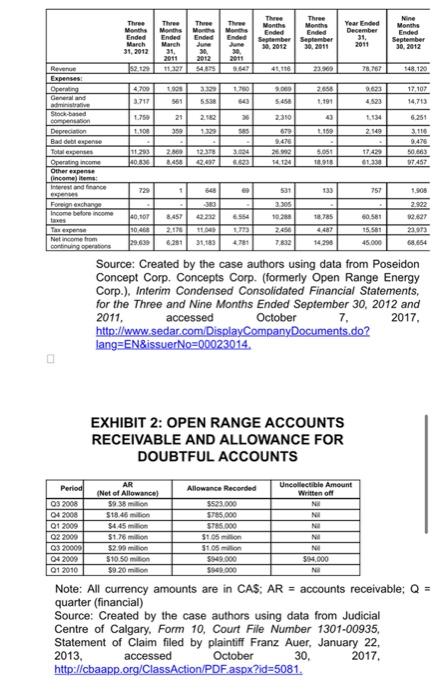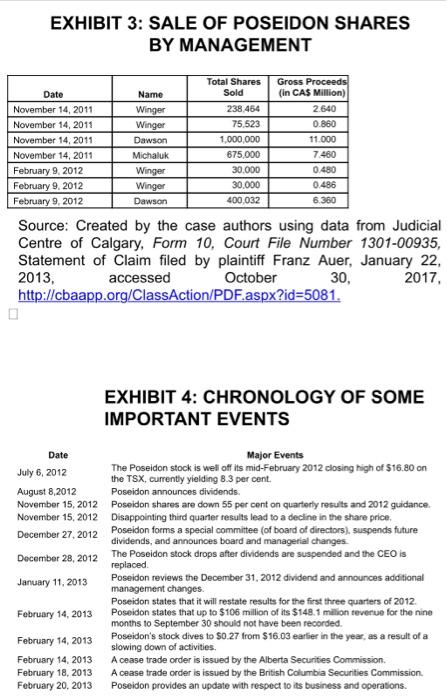ASSIGNMENT QUESTIONS
1. Differentiate between earnings management and fraud.
2. What types of accounting manipulation did Poseidon practice?
3. Calculate the average collection period. What does it indicate? What red flags can be identified from Poseidons financial statements?
4. Compare the bad debt allowance practice of Poseidon and Open Range.
5. What conclusions can you draw from the management teams decision to sell Poseidon shares?

POSEIDON CONCEPTS CORPORATION: BOOM TO BUST On February 25, 2013 Paulina Ortega, the chief investment officer (CIO) of University of Regina Investing (URI), was reviewing a draft copy of the annual report for fiscal year 2012 that was to be submitted to its client, the University of Regina. One investment that stood out was Poseidon Concepts Corporation (Poseidon), which had lost all its stock value. The investment was made in April 2012 at CAS14.02 per share and had gained 14 per cent by September, when the stock price hit a high of $16.02. Ortega decided to review the Poseidon transaction to understand the reasons for the loss on this investment, which included the potential that Poseidon's management team had manipulated its financial statements. More importantly, Ortega wondered whether there had been early signs or red flags, for such manipulation. If there were, and they had been read and acted on in time, those signs would have saved URI the loss incurred on the transaction. The ability to identify such red flags could help avoid similar situations in the future. URI The URI program was a student-run investment fund, where students managed approximately $1.5 million in funds provided by the University of Regina. The majority of these funds were contributed by the University's endowment. The program was an important aspect of the finance curriculum because it complemented the vision of the faculty to become a school of choice for experiential learning. The URI program received strong support from the Regina business community. Students in the program regularly received guest lectures and presentations from investment professionals, as well as free trading and research services from CIBC Wood Gundy. The URI fund was structured like a professional investment fund. It was headed by an executive team that included a CIO and a chief compliance officer. The student analysts were divided into sector teams, each headed by a manager. POSEIDON CONCEPTS CORPORATION History Poseidon was formed in November 2011, when the parent company, Open Range Energy Corporation (Open Range) reorganized and split into two independent entities. Open Range continued to operate as a natural gas exploration and production company, while Poseidon was structured as an energy service and supply company. Open Range shareholders of record, at the time of the reorganization, received one share of the new Open Range company and 0.8839 shares of Poseidon for each share of the old company. Poseidon inherited a management team with strong experience in the industry. Independent board members also had rich experience, both in the oil and gas sector and in capital markets. Lyle Michaluk, the vice- president (VP) of finance and chief financial officer of Open Rangc, became the chief executive officer (CEO) of Poseidon. Cliff Wicbe, who was responsible for designing the Poseidon tank system while acting as completion manager at Open Range, became the chief operating officer. Brad Wanchulak, the VP of business development at Poseidon, was previously the VP of business development at Talisman Energy. The CEO of Open Range, Scott Dawson, was appointed \&lair of the Poseidon board of directors. Michaluk and dGehe joined the board as management representatives. ge Tank Rental Business The core business of Poseidon was its proprietary tank rental to oil and gas companies. These tanks were designed by an employee of Open Range (prior to the companies splitting) to enhance operational efficiency. Once the tanks were successfully tested on Open Range's sites, the company began renting them to other companies" sites. The proprietary design of the tanks afforded them several competitive advantages in terms of costs, efficiencies, and environmental concerms. The tanks were relatively large. The larger model could handle up to 41,000 oil barrels, compared to the average conventional tank size of around 500 barrels. Despite their large size, however, Poseidon's tanks could be installed, uninstalled, and reinstalled quickly, generally within one day. They could be transported easily and more economically than the smaller conventional prefabricated tanks. The above-ground installation of Poseidon's tanks also provided huge environmental benefits, relative to the altemative of storing the fluid in lined pits. The pits experienced frequent leaks, which could not be detected until the pits were reclaimed. Due to this significant disadvantage of lined pits, Poscidon's tank rentals increased from 25 units at the end of 2010 to 170 tanks in September 2011. Poseidon supplied its tanks to both U.S. and Canadian customers. Of the company's total revenue for the nine months ending September 30, 2012,85 per cent was generated from U.S. rentals.' In the United States, Poseidon operated through a wholly owned subsidiary under the same name. Boom and Bust Poseidon started trading on the TSX on November 4, 2011 under Whacker symbel PSN. The closing price on that daggy8 ge. 52. The stock price saw a steady increase over the B00t Feveral months, peaking at $16.69 (closing price) on February 23, 2012. The stock price remained in the range of $14 to $15 until November 2012 . During this period, investors remained optimistic about the firm's prospects. Some analysts considered management's earnings guidance to be too conservative, setting a higher target price for the company. On November 14, 2012, Poseidon issued financial statements for the third quarter of 2012, as well as for the nine months ending September 2012. In these statements, Poseidon reported an increase in accounts receivable to $125.5 million, out of which $36 million was outstanding for more than 120 days. It also took a charge of $9.5 million for bad debt. 1 Market backlash was strong following Poseidon's disclosures. The next day, on November 15, 2012, the company's stock price plunged to $5.00 - a drop of 62 per cent from the previous day's closing price of $13.22. On December 27, 2012, Poseidon established a special committee of the board to investigate the controversy surrounding the company's accounts receivable. The committee retained legal counsel, who in turn consulted with Ernst and Young lnc. The findings of the investigation were disclosed on February 14, 2013. Poseidon admitted that it had materially inflated revenues. In particular, \$106 million out of $148 million total revenue for the period January to September 2012 was based on non-existing or uncollectible take-or-pay contracts, and should not have been recorded as revenues.? Long-term sales and service contracts were common in the mining industry and in the oil and gas industry. One type of long-term contract-the take-or-pay arrangement-obliged Poseidon's customers to rent a minimum number of tanks at an agreed rate. Poseidon offered many take-or-pay contracts to its U.S. customers. After the investigation, Poseidon announced that it would restate its financial statements according to the findings. However, stock trading ceased altogether upon this disclosure on February THE ANALYSIS Ortega looked up the historical quarterly financial statements of Poseidon (see Exhibit 1). Her goal was to identify any red flags that her team could have missed, so that they could be better prepared to avoid such scenarios in the future. The November 15 announcement that triggered the downward spiral in the stock price was related to accounts receivable and a considerable bad debt expense recognition. Therefore, Ortega collected data relating to accounts receivable and bad debt allowance for Poseidon's parent company, and compared the two companies' accounting practices (see Exhibit 2). While looking for the company's historical financial statements, Ortega stumbled upon a record detailing a number of Poseidon shares sold by the CEO, the chair of the board, and a third director (see Exhibit 3). She wondered if the particular timing of these sales was indicative of the events that followed thereafter. In order to put things in perspective and organize her thoughts, Ortega listed chronologically all the significant events to date about Poseidon (see Exhibit 4). Was there a revelation in the information she had collected? Could this information be valuable to avoid a similar issue in the future? EXHIBIT 1: POSEIDON HISTORICAL FINANCIAL STATEMENTS (IN CAS THOUSANDS) Panel A: Statements of Financial Position Source: Created by the case authors using data from Poseidon Concept Corp. Concepts Corp. (formerly Open Range Energy Corp.). Interim Condensed Consolidated Financial Statements, for the Three and Nine Months Ended September 30, 2012 and 2011, accessed 2017 , http:illwww sedar.comidisplayCompanyDocuments.do? lang =EN \&issuerNo=00.023.014. EXHIBIT 2: OPEN RANGE ACCOUNTS RECEIVABLE AND ALLOWANCE FOR DOUBTFUL ACCOUNTS Note: All currency amounts are in CAS; AR= accounts receivable; Q= quarter (financial) Source: Created by the case authors using data from Judicial Centre of Calgary. Form 10, Court File Number 1301-00935, Statement of Claim filed by plaintiff Franz Auer, January 22, EXHIBIT 3: SALE OF POSEIDON SHARES BY MANAGEMENT Source: Created by the case authors using data from Judicial Centre of Calgary, Form 10, Court File Number 1301-00935, Statement of Claim filed by plaintiff Franz Auer, January 22, 2013, accessed 2017. http:///cbaapp.org/ClassAction/PDF.aspx?id=5081. EXHIBIT 4: CHRONOLOGY OF SOME IMPORTANT EVENTS












